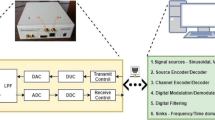Abstract
IEEE 802.11n compliant receivers are composed of a number of functional blocks, each one with a specific computational complexity and requirements for numerical precision. MIMO preprocessing causes a major part of the computational complexity, since it typically consists of operations like QR decompositions or matrix inversions. Hence, it also demands considerable numerical precision, while other parts of the transceiver, e.g. MIMO equalization or OFDM modulation, need significantly less accuracy. Various publications exist on the issue of ASIC design for MIMO preprocessing. However, the increasing variety of mobile communication standards calls for more flexible platforms, implementing the different standards in software, hence called Software Defined Radios (SDRs). This work focuses on achieving bit error rates (BERs) close to floating-point performance while using the limited fixed-point precision typically available on SDR platforms. To that end, several algorithmic enhancements are described that enable a numerically stable MIMO application even on a 16-bit fixed-point platform. These enhancements are implemented on the maturing P2012 platform by ST Microelectronics as proof-of-concept. Execution time as well as error correction performance are discussed as quality indicators of the implementation.



Similar content being viewed by others
References
Zyren, J. (2007). Overview of the 3GPP long term evolution physical layer.
IEEE Standard for Information technology–Telecommunications and information exchange between systems–Local and metropolitan area networks–Specific requirements Part 11, Amendment 5. IEEE Std 802.11n-2009 (pp. c1–502). October 2009.
van Berkel, K., Heinle, F., Meuwissen, P.P.E., Moerman, K., Weiss, M. (2005). Vector processing as an enabler for software-defined radio in handheld devices. EURASIP Journal of Applied Signal Processing, 2005, 2613–2625.
Fuin, D., Benini, L., Flamand, E., Melpignano, D. (2012). P2012: Building an ecosystem for a scalable, modular and high-efficiency embedded computing accelerator. In DATE’12.
Texas Instruments Inc. Q4 TMS320C64x/C64x+ DSP - CPU and instruction set (2010).
Kim, H.S., Zhu, W., Bhatia, J., Mohammed, K., Shah, A., Daneshrad, B. (2008). A practical hardware friendly MMSE detector for MIMO-OFDM-based systems. EURASIP Journal of Advanced Signal Processing, 2008, 94:1–94:14.
STMicroelectronics (June 2010) STxP70-4 Core and Instruction Set Architecture. 8154580 Rev. B. http://www.st.com/.
Luethi, P.J. (2009). VLSI circuits for MIMO preprocessing. ETH.
Wuebben, D., Bohnke, R., Kuhn, V., Kammeyer, K.-D. (2003). MMSE extension of V-BLAST based on sorted QR decomposition. In Vehicular Technology Conference, 2003. VTC 2003-Fall. 2003 IEEE 58th Vol. 1 (pp. 508–512). October 2003.
Wubben, D., Bohnke, R., Rinas, J., Kuhn, V., Kammeyer, K.D. (2001). Efficient algorithm for decoding layered space-time codes. Electronics Letters, 37(22), 1348–1350.
Fast Inverse Square Root. Chris lomont (2003). http://www.lomont.org/Math/Papers/2003/InvSqrt.pdf.
Collings, I.B., Butler, M.R.G., McKay, M. (2004). Low complexity receiver design for MIMO bit-interleaved coded modulation. In International symposium on spread spectrum techniques and applications.
Luethi, P., Studer, C., Duetsch, S., Zgraggen, E., Kaeslin, H., Felber, N., Fichtner, W. (2008). Gram-Schmidt-based QR decomposition for MIMO detection: VLSI implementation and comparison. In IEEE Asia pacific conference on circuits and systems, 2008. APCCAS 2008 (pp. 830–833). 30 2008-December 3.
Kempf, T., Guenther, D., Ishaque, A., Ascheid, G. MIMO OFDM transceiver for a many-core computing fabric—A nucleus based implementation. In SDR’11—The wireless innovation forum conference on communications technologies and software defined radio Washington D.C., December.
Perahia, E., & Stacey, R. (2008). Next generation wireless LANS. New York: Cambridge University Press.
Zimmermann, E., & Fettweis, G. Adaptive vs. hybrid iterative MIMO receivers based on MMSE linear and soft-SIC detection. In 2006 IEEE 17th international symposium on personal, indoor and mobile radio communications (pp. 1–5), September 2006.
Wubben, D., Bohnke, R., Kuhn, V., Kammeyer, K.-D. (2004). Near-maximum-likelihood detection of MIMO systems using MMSE-based lattice reduction. In 2004 IEEE international conference on communications, Vol. 2 (pp. 798–802).
Texas Instruments Inc. TMS320C645x DSP Viterbi-Decoder Coprocessor 2 (VCP2) User’s Guide, 2009.
Borlenghi, F., Witte, E.M., Ascheid, G., Meyr, H., Burg, A. (2011). A 772Mbit/s 8.81bit/nJ 90nm CMOS soft-input soft-output sphere decoder. In Solid state circuits conference (A-SSCC), 2011 IEEE Asian (pp. 297–300).
Author information
Authors and Affiliations
Corresponding author
Additional information
This work has been supported by the UMIC Research Centre, RWTH Aachen University and by the EC under grant 2PARMA FP7-248716.
Rights and permissions
About this article
Cite this article
Guenther, D., Kempf, T. & Ascheid, G. Numerical Aspects of MIMO OFDM PHY Layer Applications on SDR Platforms. J Sign Process Syst 73, 291–300 (2013). https://doi.org/10.1007/s11265-013-0766-y
Received:
Accepted:
Published:
Issue Date:
DOI: https://doi.org/10.1007/s11265-013-0766-y




